Abstract
1. The diffusive water permeability of epithelial cell membranes in the perfused rabbit mandibular salivary gland was measured at 37 degrees C by a 1H nuclear magnetic resonance relaxation method using an extracellular relaxation reagent, gadolinium diethylenetriaminepentaacetic acid (Gd(DTPA)). 2. In glands perfused with a HEPES-buffered solution containing 10 mmol l-1 Gd(DTPA), the spin-lattice (T1) relaxation of the water protons showed two exponential components. The water compartment responsible for the slower component corresponded in magnitude to 71 +/- 5% of the wet weight of the gland, and was attributed to the exchangeable intracellular water of the acinar cells. 3. The rate constant for water efflux from the cells was estimated to be 4.1 +/- 0.1 s-1 which would be consistent with a diffusive membrane permeability (Pd) of approximately 3 x 10(-3) cm s-1. Stimulation with acetylcholine (10(-6) mol l-1) did not cause any detectable change in membrane water permeability. 4. Since the basolateral membrane probably provides the main pathway for water efflux, the osmotic water permeability of this barrier (expressed per gland) was estimated to be less than 6.2 cm3 s-1. This would be insufficient to account for the generation of a near-isosmotic fluid at the flow rates observed during secretion, and suggests that a substantial fraction of the flow of water occurs via a paracellular route.
Full text
PDF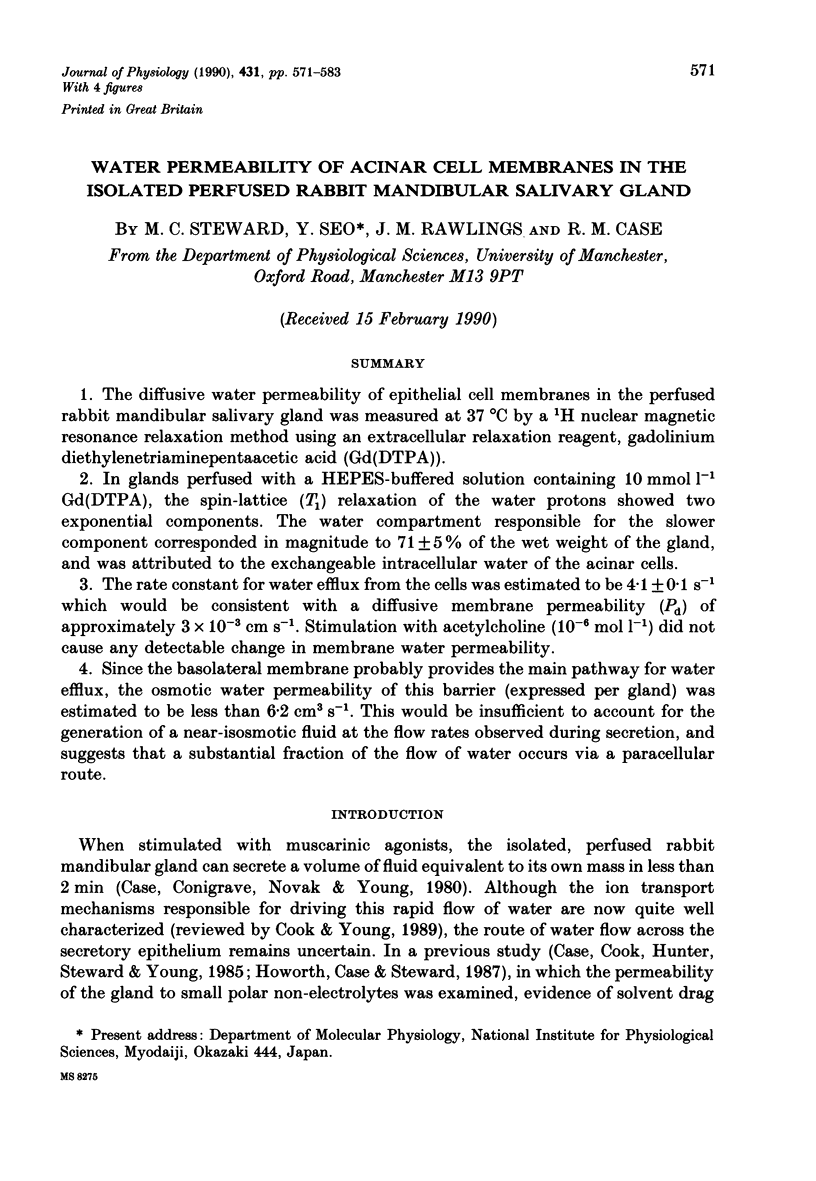
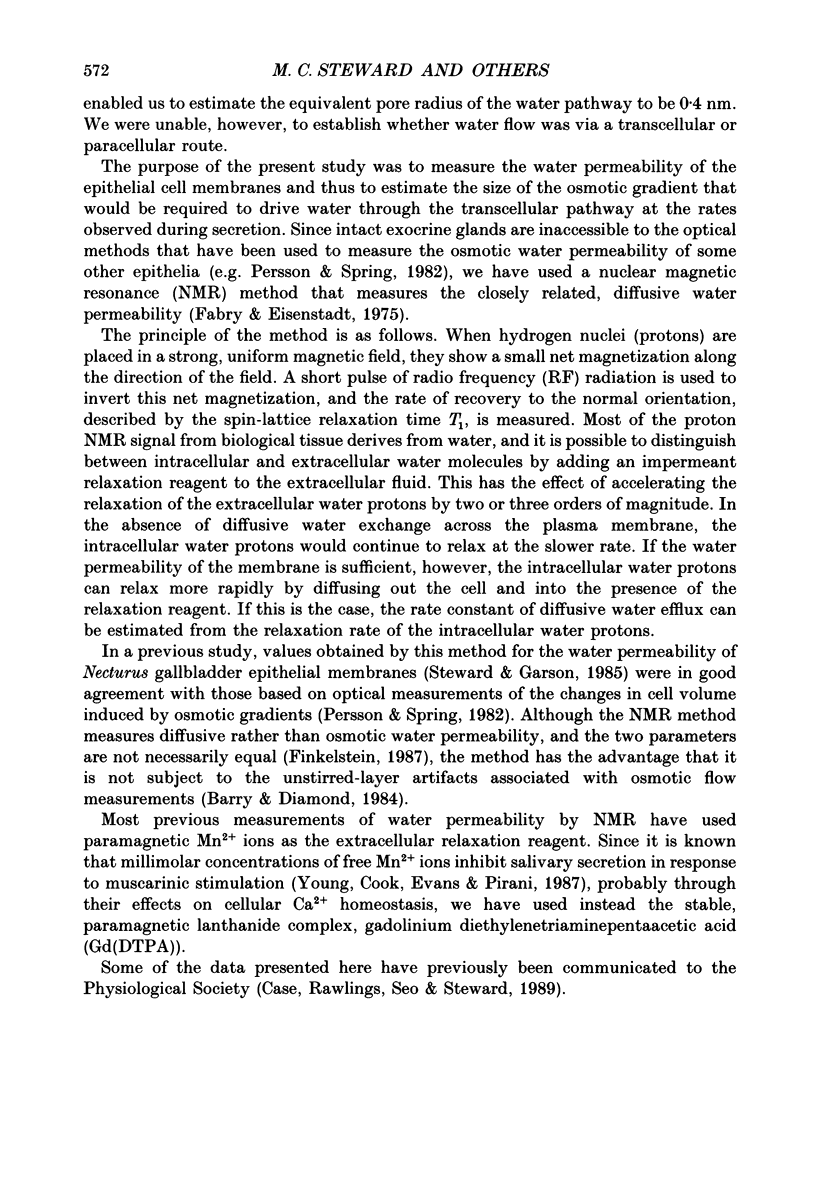
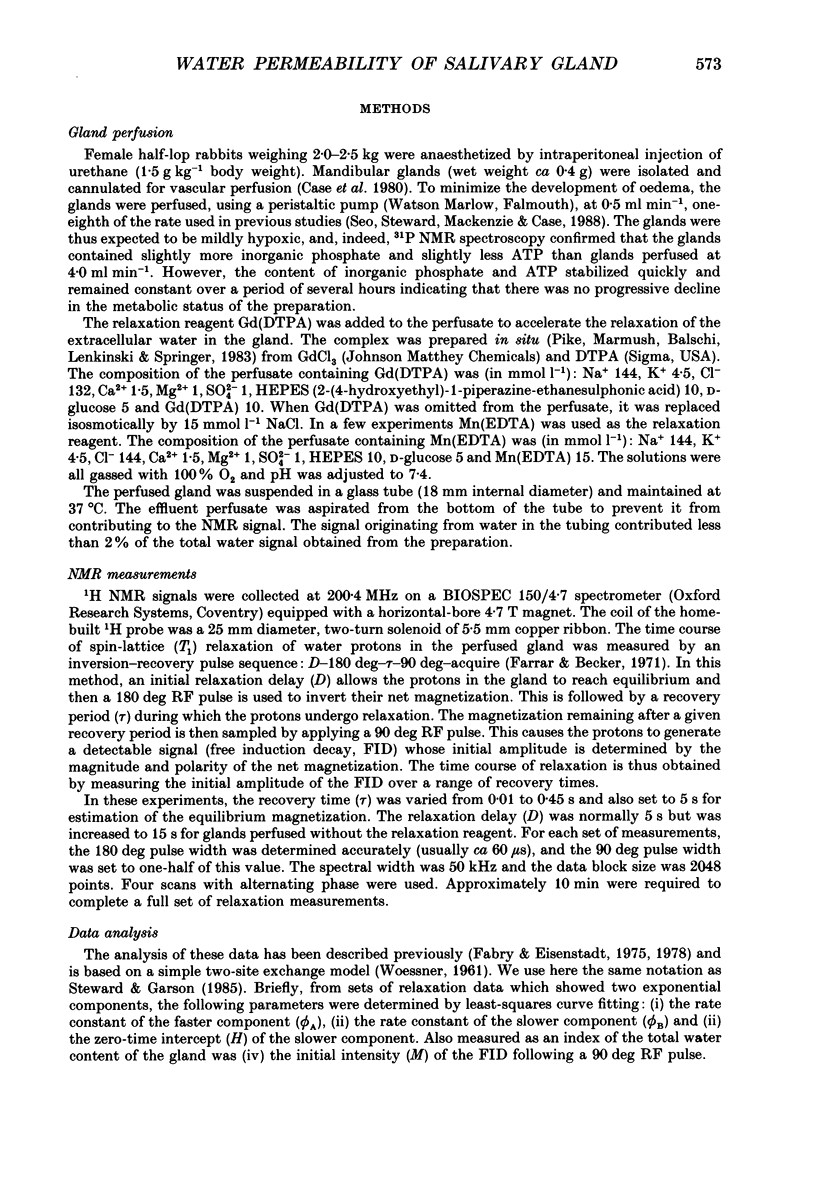
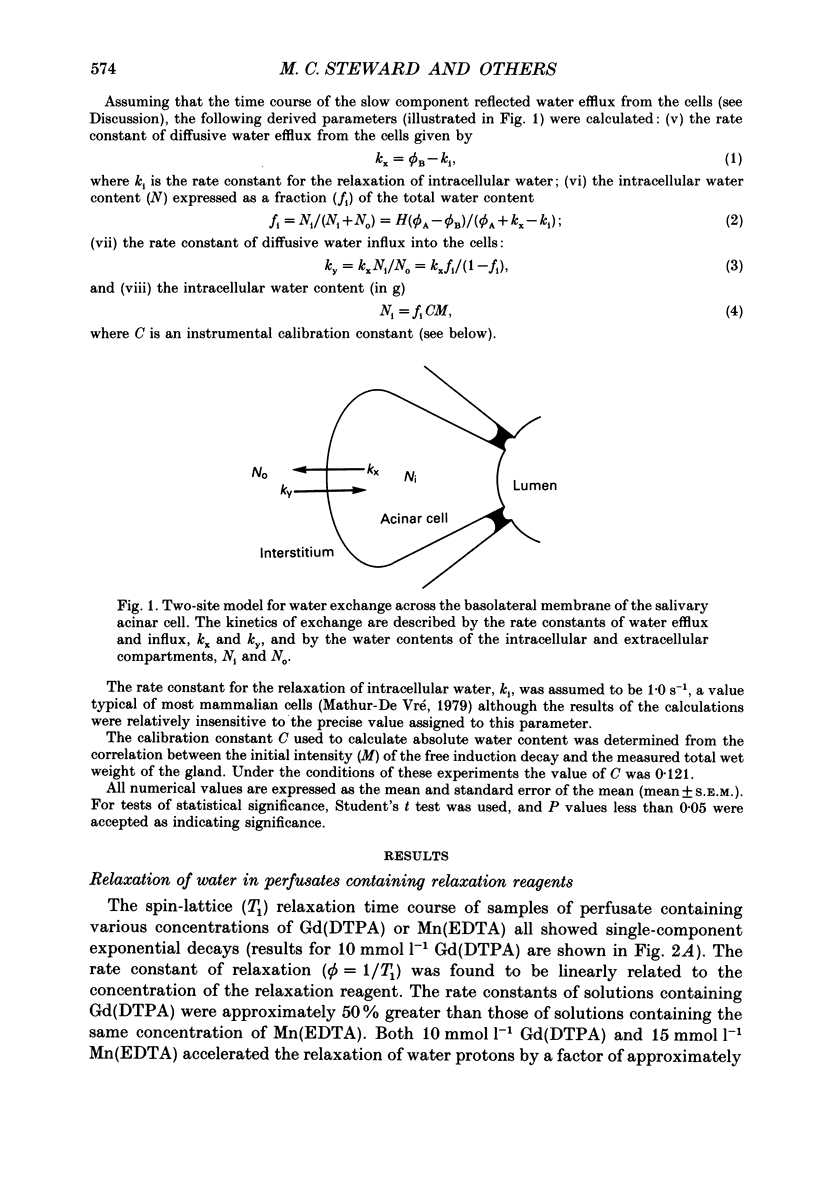
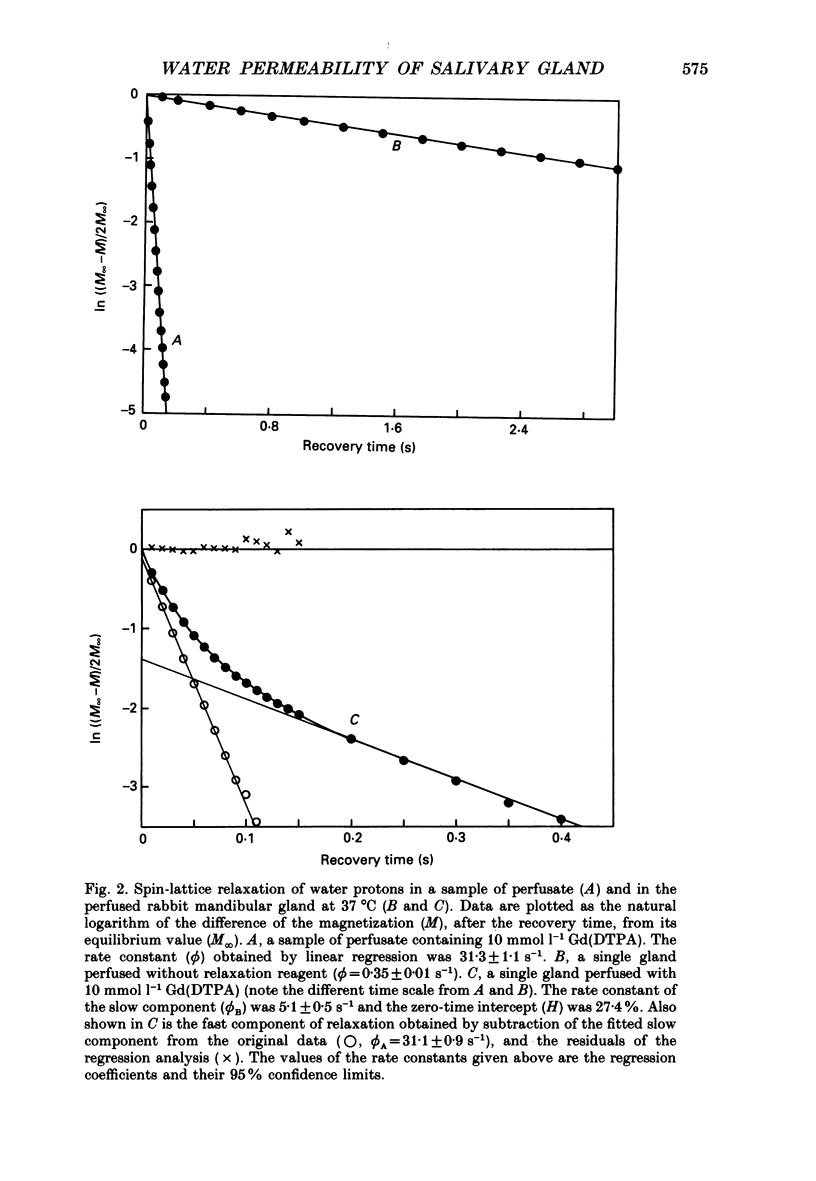
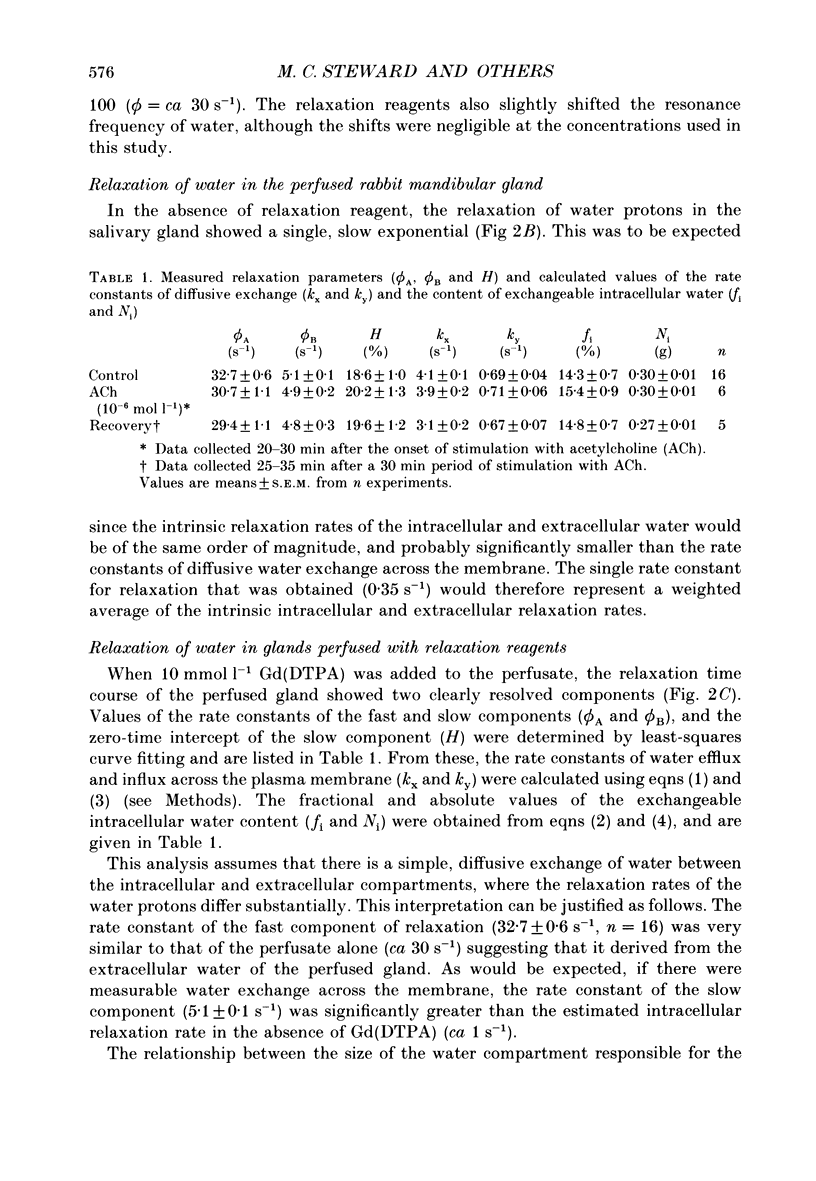
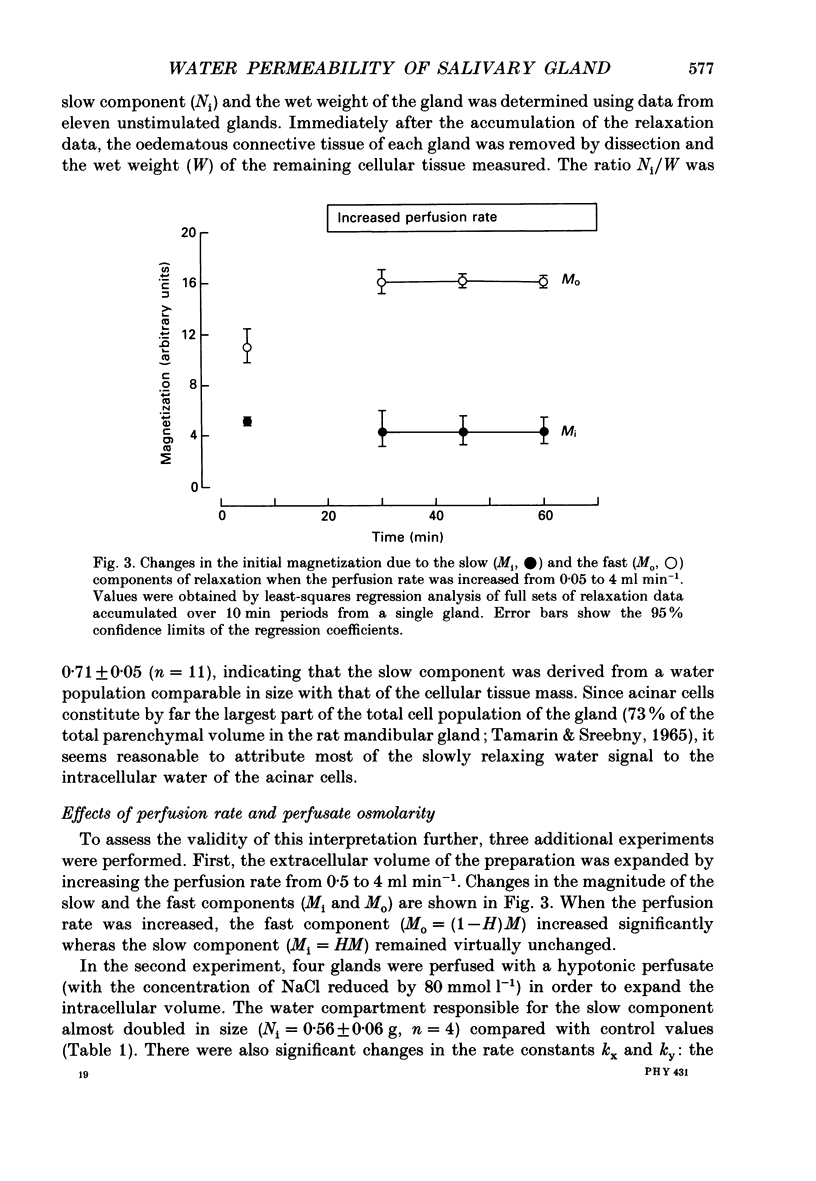
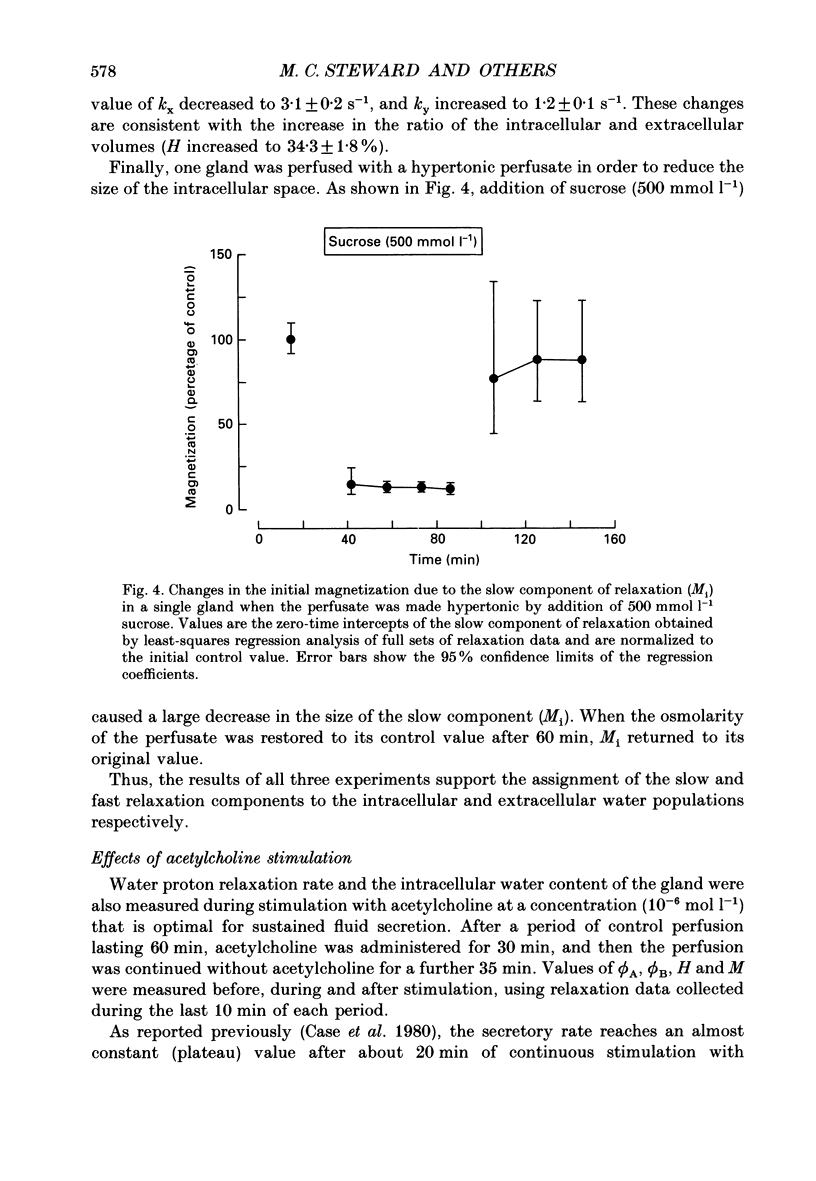
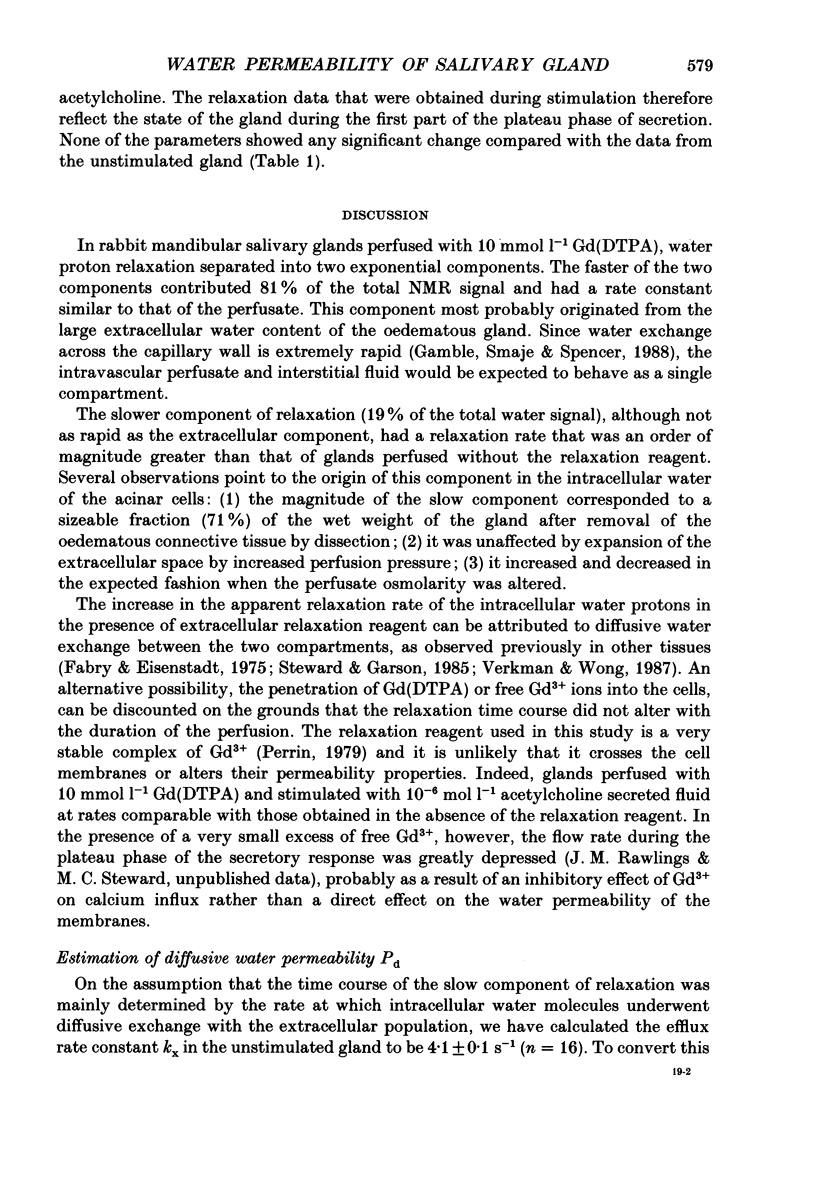
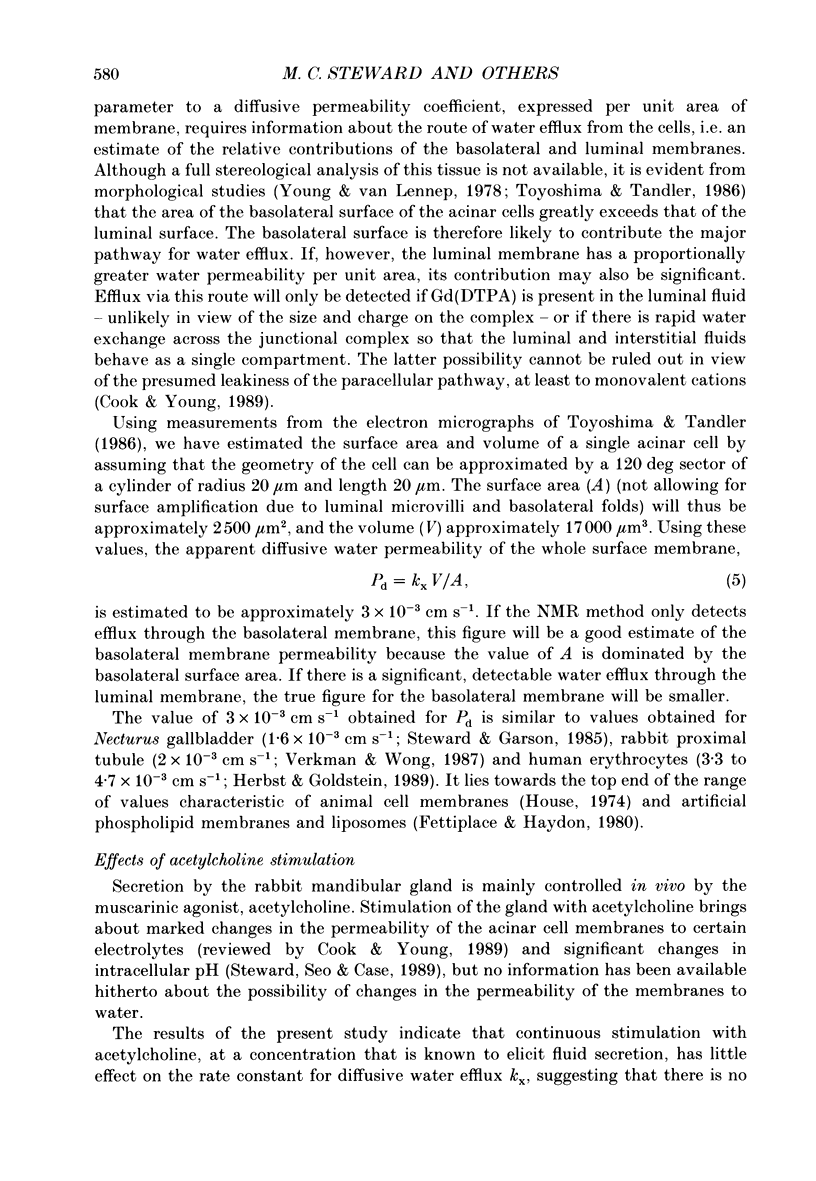
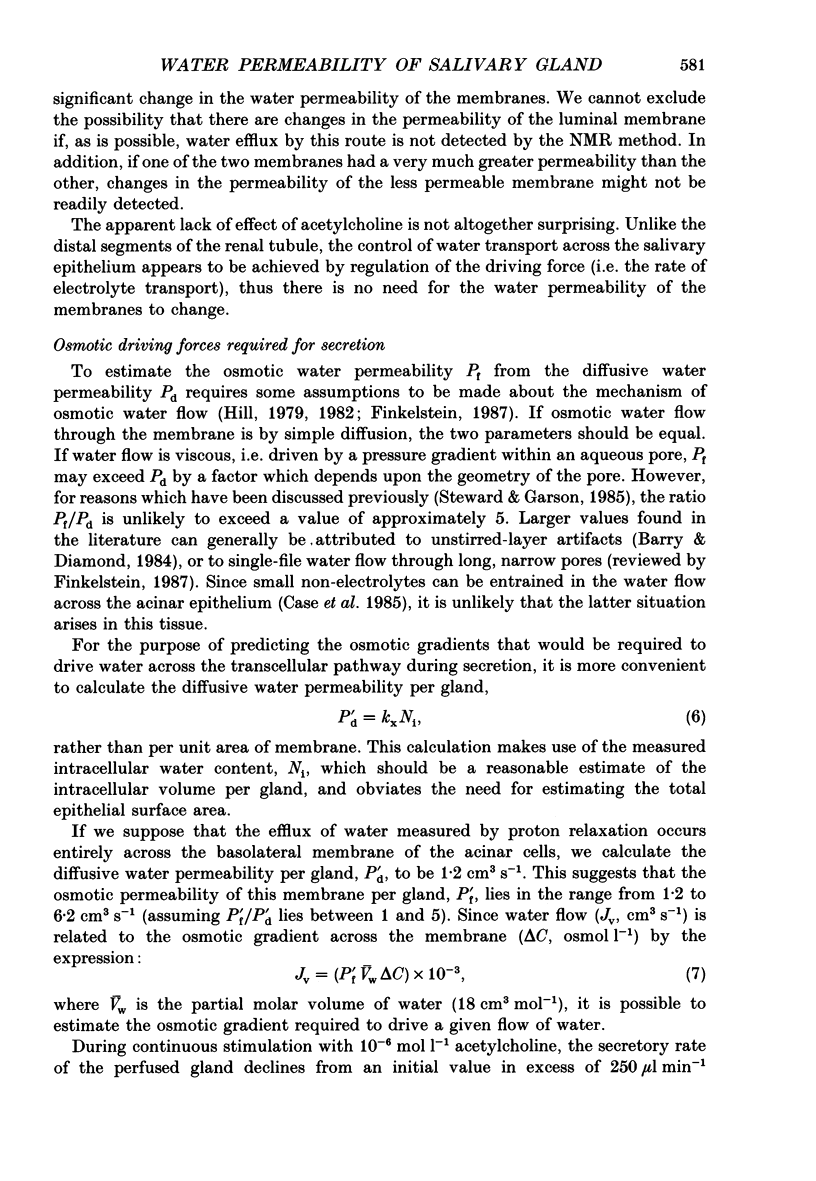
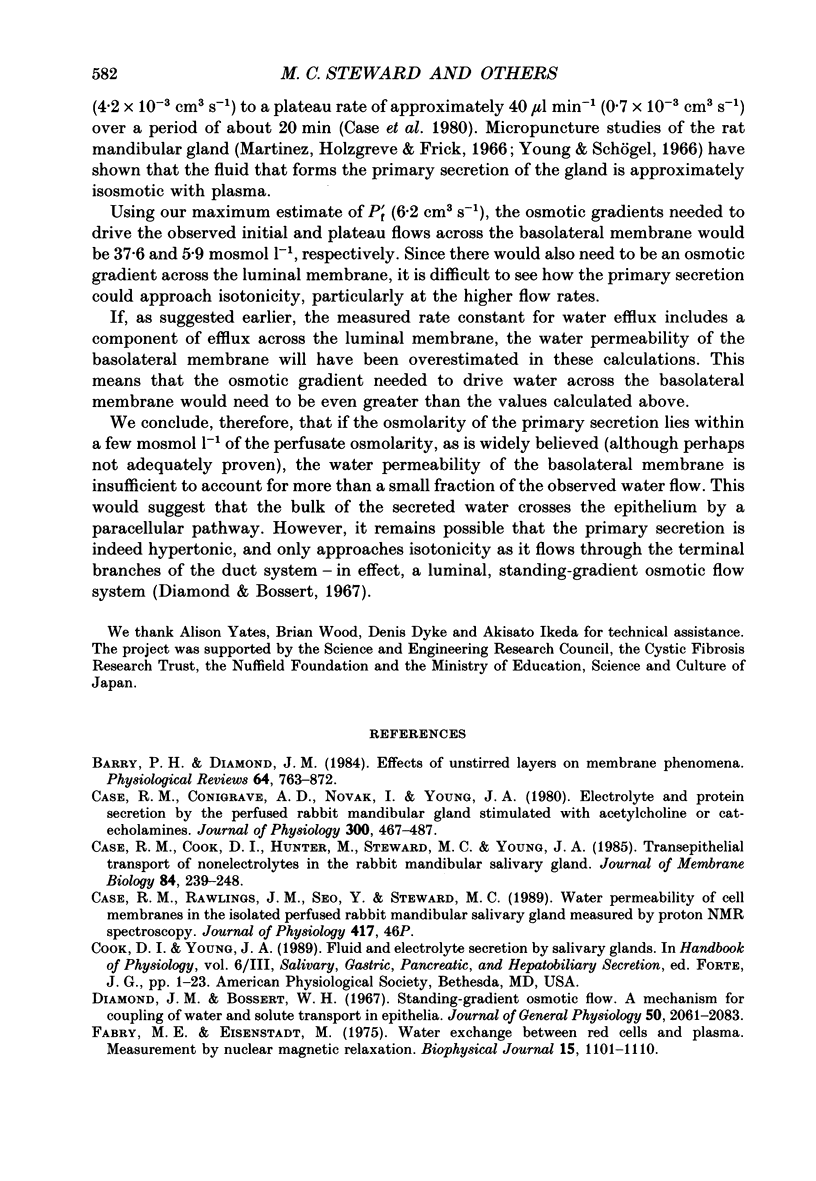
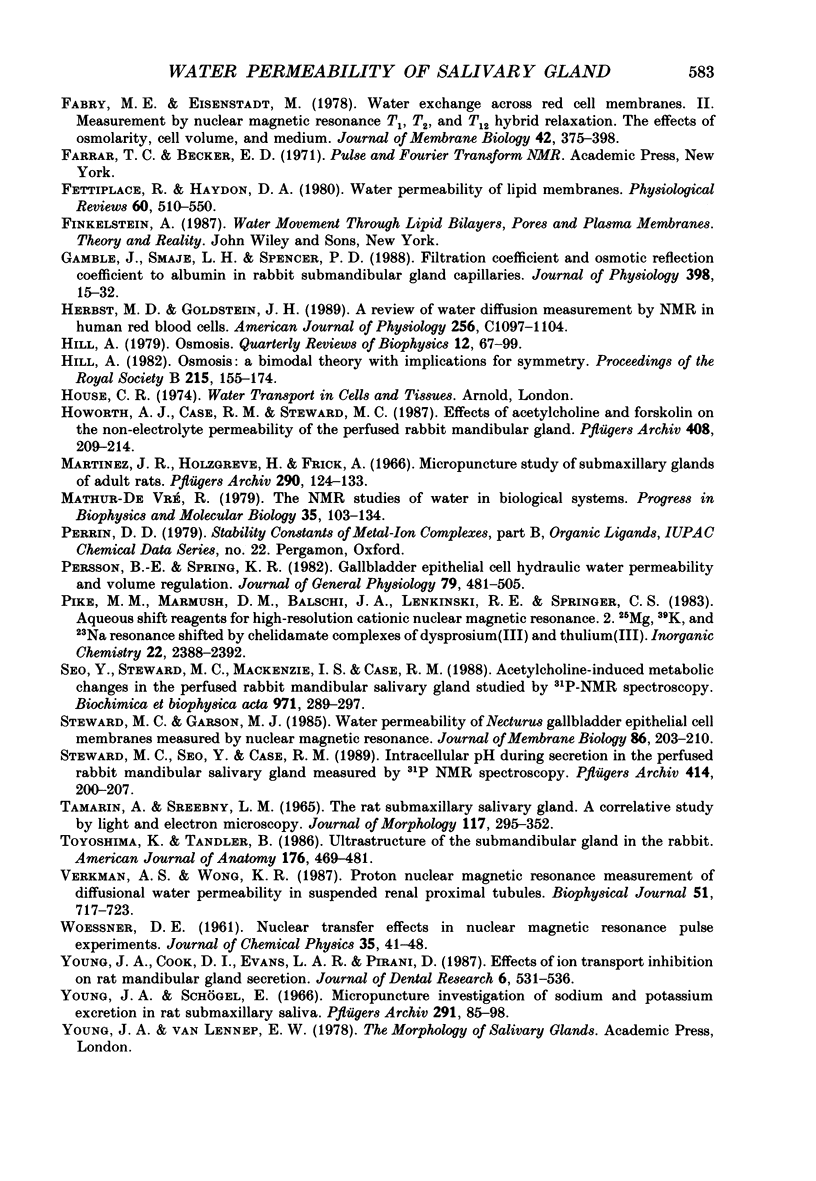
Selected References
These references are in PubMed. This may not be the complete list of references from this article.
- Barry P. H., Diamond J. M. Effects of unstirred layers on membrane phenomena. Physiol Rev. 1984 Jul;64(3):763–872. doi: 10.1152/physrev.1984.64.3.763. [DOI] [PubMed] [Google Scholar]
- Case R. M., Conigrave A. D., Novak I., Young J. A. Electrolyte and protein secretion by the perfused rabbit mandibular gland stimulated with acetylcholine or catecholamines. J Physiol. 1980 Mar;300:467–487. doi: 10.1113/jphysiol.1980.sp013173. [DOI] [PMC free article] [PubMed] [Google Scholar]
- Case R. M., Cook D. I., Hunter M., Steward M. C., Young J. A. Transepithelial transport of nonelectrolytes in the rabbit mandibular salivary gland. J Membr Biol. 1985;84(3):239–248. doi: 10.1007/BF01871387. [DOI] [PubMed] [Google Scholar]
- Diamond J. M., Bossert W. H. Standing-gradient osmotic flow. A mechanism for coupling of water and solute transport in epithelia. J Gen Physiol. 1967 Sep;50(8):2061–2083. doi: 10.1085/jgp.50.8.2061. [DOI] [PMC free article] [PubMed] [Google Scholar]
- Fabry M. E., Eisenstadt M. Water exchange across red cell membranes: II. Measurements by nuclear magnetic resonance T1, T2, and T12 hybrid relaxation. The effects of osmolarity, cell volume, and medium. J Membr Biol. 1978 Sep 25;42(4):375–398. doi: 10.1007/BF01870357. [DOI] [PubMed] [Google Scholar]
- Fabry M. E., Eisenstadt M. Water exchange between red cells and plasma. Measurement by nuclear magnetic relaxation. Biophys J. 1975 Nov;15(11):1101–1110. doi: 10.1016/S0006-3495(75)85886-3. [DOI] [PMC free article] [PubMed] [Google Scholar]
- Fettiplace R., Haydon D. A. Water permeability of lipid membranes. Physiol Rev. 1980 Apr;60(2):510–550. doi: 10.1152/physrev.1980.60.2.510. [DOI] [PubMed] [Google Scholar]
- Gamble J., Smaje L. H., Spencer P. D. Filtration coefficient and osmotic reflection coefficient to albumin in rabbit submandibular gland capillaries. J Physiol. 1988 Apr;398:15–32. doi: 10.1113/jphysiol.1988.sp017026. [DOI] [PMC free article] [PubMed] [Google Scholar]
- Herbst M. D., Goldstein J. H. A review of water diffusion measurement by NMR in human red blood cells. Am J Physiol. 1989 May;256(5 Pt 1):C1097–C1104. doi: 10.1152/ajpcell.1989.256.5.C1097. [DOI] [PubMed] [Google Scholar]
- Hill A. Osmosis. Q Rev Biophys. 1979 Feb;12(1):67–99. doi: 10.1017/s0033583500002602. [DOI] [PubMed] [Google Scholar]
- Hill A. Osmosis: a bimodal theory with implications for symmetry. Proc R Soc Lond B Biol Sci. 1982 May 22;215(1199):155–174. doi: 10.1098/rspb.1982.0035. [DOI] [PubMed] [Google Scholar]
- Howorth A. J., Case R. M., Steward M. C. Effects of acetylcholine and forskolin on the non-electrolyte permeability of the perfused rabbit mandibular gland. Pflugers Arch. 1987 Mar;408(3):209–214. doi: 10.1007/BF02181460. [DOI] [PubMed] [Google Scholar]
- Martinez J. R., Holzgreve H., Frick A. Micropuncture study of submaxillary glands of adult rats. Pflugers Arch Gesamte Physiol Menschen Tiere. 1966;290(2):124–133. doi: 10.1007/BF00363690. [DOI] [PubMed] [Google Scholar]
- Mathur-De Vré R. The NMR studies of water in biological systems. Prog Biophys Mol Biol. 1979;35(2):103–134. doi: 10.1016/0079-6107(80)90004-8. [DOI] [PubMed] [Google Scholar]
- Persson B. E., Spring K. R. Gallbladder epithelial cell hydraulic water permeability and volume regulation. J Gen Physiol. 1982 Mar;79(3):481–505. doi: 10.1085/jgp.79.3.481. [DOI] [PMC free article] [PubMed] [Google Scholar]
- Seo Y., Steward M. C., Mackenzie I. S., Case R. M. Acetylcholine-induced metabolic changes in the perfused rabbit mandibular salivary gland studied by 31P-NMR spectroscopy. Biochim Biophys Acta. 1988 Oct 7;971(3):289–297. doi: 10.1016/0167-4889(88)90144-9. [DOI] [PubMed] [Google Scholar]
- Steward M. C., Garson M. J. Water permeability of Necturus gallbladder epithelial cell membranes measured by nuclear magnetic resonance. J Membr Biol. 1985;86(3):203–210. doi: 10.1007/BF01870599. [DOI] [PubMed] [Google Scholar]
- Steward M. C., Seo Y., Case R. M. Intracellular pH during secretion in the perfused rabbit mandibular salivary gland measured by 31P NMR spectroscopy. Pflugers Arch. 1989 Jun;414(2):200–207. doi: 10.1007/BF00580964. [DOI] [PubMed] [Google Scholar]
- Tamarin A., Sreebny L. M. The rat submaxillary salivary gland. A correlative study by light and electron microscopy. J Morphol. 1965 Nov;117(3):295–352. doi: 10.1002/jmor.1051170303. [DOI] [PubMed] [Google Scholar]
- Toyoshima K., Tandler B. Ultrastructure of the submandibular gland in the rabbit. Am J Anat. 1986 Aug;176(4):469–481. doi: 10.1002/aja.1001760409. [DOI] [PubMed] [Google Scholar]
- Verkman A. S., Wong K. R. Proton nuclear magnetic resonance measurement of diffusional water permeability in suspended renal proximal tubules. Biophys J. 1987 May;51(5):717–723. doi: 10.1016/S0006-3495(87)83398-2. [DOI] [PMC free article] [PubMed] [Google Scholar]
- Young J. A., Cook D. I., Evans L. A., Pirani D. Effects of ion transport inhibition on rat mandibular gland secretion. J Dent Res. 1987 Feb;66(2):531–536. doi: 10.1177/00220345870660022401. [DOI] [PubMed] [Google Scholar]
- Young J. A., Schögel E. Micropuncture investigation of sodium and potassium excretion in rat submaxillary saliva. Pflugers Arch Gesamte Physiol Menschen Tiere. 1966;291(1):85–98. doi: 10.1007/BF00362654. [DOI] [PubMed] [Google Scholar]


